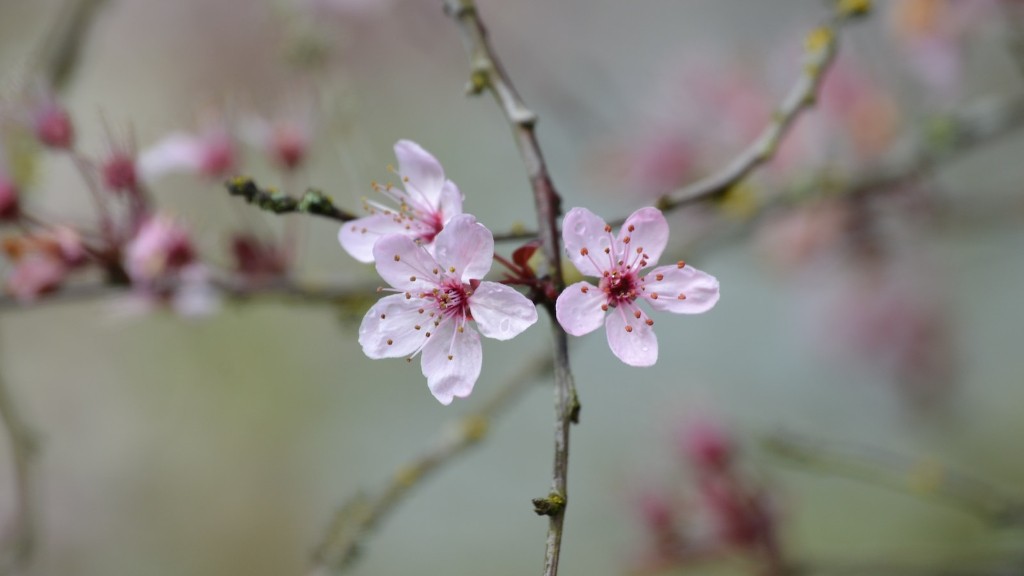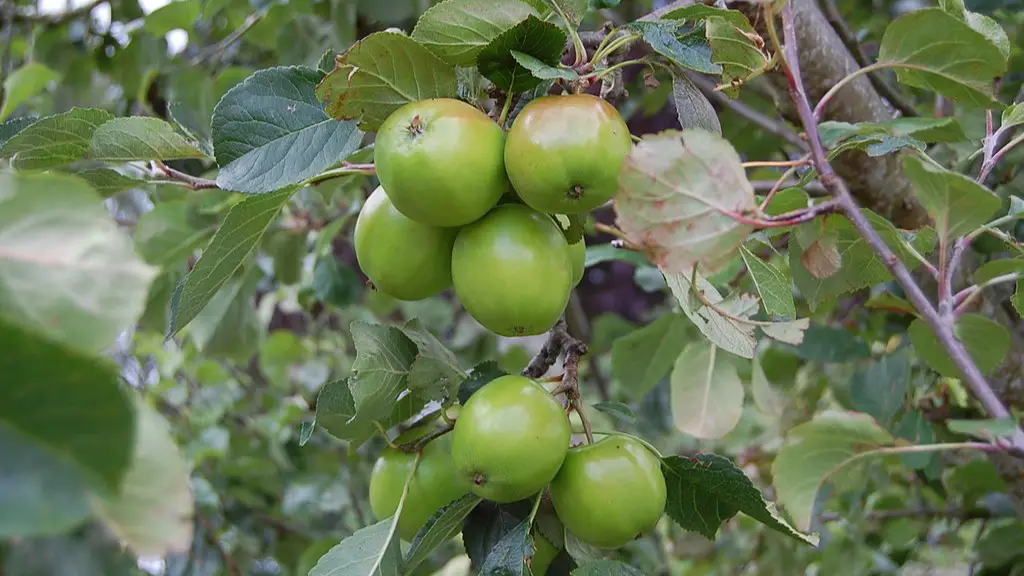Cherry trees produce fruit throughout the world in different climates. The presence of cherries in gardens, orchards and wild forests is a sight that has been enjoyed by generations of inhabitants of the northern hemisphere. Yet, despite their popularity, many are not sure when a cherry tree will produce its fruit. Understanding when cherry trees produce fruit requires an understanding of the tree’s biology.
A cherry tree produces flowers very early in the spring. The blooming of the cherry flower depends on the specific variety and is also influenced by the climate and weather. Once the flowers have bloomed, the pollination process begins, meaning the blossoms produce pollen on a mass scale. This pollen is then absorbed by the trees’ stamens, allowing the fertility of the flowers and ultimately, fruit formation.
The pollination process can take anywhere from two weeks to a month, depending on the weather conditions. After pollination, the fruit starts to develop and will eventually fall off. Cherries can be harvested anytime between late summer until early autumn, although this will vary depending on the type of tree and its location. Early cherry varieties like Early Richmond will typically be ready for harvesting around mid-July, while later varieties like Stella and Lapins can be harvested in August and September.
The harvesting process requires some skill and patience. The cherries should be picked when they’re ripe and their skin has changed color to a deep red and their flesh is juicy and firm. Ripe cherries are usually tree-ripe, however, picking the fruit a little earlier can provide better harvesting conditions and prevent over-ripening. Once picked, cherry fruits must be handled carefully because they bruise easily.
Cherry trees can be a beautiful addition to any garden and provide an abundance of fruit each season. Knowing when a cherry tree produces fruit will allow gardeners to get the most out of their tree’s harvest. By understanding the pollination and development processes of a cherry tree, gardeners will have a better idea of when the fruit will finally be ready for collecting and enjoying!
Cultivation of Cherry Trees
The cultivation of cherry trees can be challenging depending on the climate and soil in the garden. They should be planted in full sun, preferably in a sheltered and sunny site. When choosing a spot, take into account the size of the tree at full maturity as, depending on the variety, cherry trees can get quite big and require enough root space as well as room for sun exposure. The soil is also an important consideration. Cherry trees prefer well-drained, fertile soil with a pH ranging from 6 to 7. To provide enough nutrients and strengthen the tree, light organic fertilizers can be regularly applied.
Cherry trees should be pruned on a regular basis. Pruning is a very important part of cherry tree cultivation because it ensures the tree remains healthy and contributes to the quality of the fruit. Pruning helps to clean dead and diseased wood, and it also shapes the tree and increases its productivity. For the best results, pruning should be done in spring at the same time when the tree is blooming.
Cherry trees are considered fairly disease-resistant and do not require much additional pest control. Gardeners should, however, keep an eye out for insects and birds which tend to feed on the ripening fruits. To keep pests away, it’s possible to cover the tree with a net or extend the harvest season by picking ripe fruits before birds get the chance.
With the correct care, cherry trees can produce several harvests of juicy and delicious fruits every year for many years to come. Effective maintenance and cultivation will allow cherry trees to reach their full potential, providing a continuous supply of healthful fruits for years to come.
Nutritional Benefits of Cherry Trees
Cherry trees offer a variety of health benefits. Its fruit is rich in antioxidants, vitamins and minerals, making it a nutritious snack. Cherries contain vitamin A, C and E, as well as folate, magnesium, iron and potassium. They’re a great source of dietary fiber and also offer an array of bioactive phytochemicals. The presence of these compounds makes cherries an important part of a healthy diet.
Their significant amount of antioxidants helps to reduce inflammation and is known to have an anti-aging effect in the body. Furthermore, studies have shown that regularly consuming cherries is linked to lower cholesterol and blood glucose levels and can also reduce the risk of certain cardiovascular diseases. With such vast nutritional benefits, cherries can form part of a wholesome and balanced diet.
Cherry trees are also great for cooking. Their fruit can be used in sweet and savory dishes, making them a valuable ingredient in kitchens around the world. When cooked, cherries become sweeter and more well-rounded in flavor, allowing them to complement many different dishes. They can also be enjoyed fresh and many people also choose to make jams and preserves out of cherries, preserving their flavor and vitality for months.
Eating cherries straight off the tree can be a great way to relax and enjoy the summertime. Whether someone is picking cherries for cooking or for eating, cherry trees offer delicious and healthful fruits for any occasion.
Choosing the Right Variety
Because of their popularity, cherry trees come in a wide variety of shapes and sizes. Picking the right variety for one’s needs requires a bit of research and knowledge about the different types of cherry trees. Firstly, determine the type of tree that suits the garden size and ther climate in the garden. Secondly, consider the type of fruit being desired. Sweet cherries are better for eating, while tart cherries are used mainly for making jams and pies.
The next step is to think about the chill required. This refers to the bare minimum temperature to which a tree needs to be exposed in order to produce fruit. Different types of cherry trees require different temperatures, so it’s important to be aware of the variety’s requirements before planting.
Finally, consider the ripening season and harvest time. Early-ripening varieties should be planted in colder climates, while late-ripening varieties require warmer climates. Also consider how quickly the fruit will ripen and how long it’ll be available for. Knowing all this information will help gardeners select the appropriate variety for their specific needs.
Storing Cherry Fruits
The cherries harvested from the tree will keep for some weeks, however, the bigger the cherry, the shorter its shelf life. As such, it’s important to store the fruits properly in order to preserve as much of their quality and nutritional value as possible.
For long-term storage, cherries should be frozen as soon as they’re picked. Place them in a single layer on a tray, then freeze and transfer to a plastic bag. The freezer should be set to -18 ̊C (0 ̊F). Frozen cherries will keep for up to 10 months. For short-term storage, cherries can be kept in the refrigerator in an airtight container. They’ll last for up to a month.
Though frozen cherries are best for long-term storage, they can also be used in cooking when thawed. For instance, they can be used in jams, pies, cobblers and other desserts. They can also be added to smoothies and other drinks for a tasty and nutritious treat.
In order to make the most out of the cherries from one’s cherry tree, it is important to store them properly. With proper care, cherry fruits can continue to bring joy to homes long after they’ve been harvested from the tree.
Uses for Cherry Trees
Cherry trees are extremely versatile and offer a variety of uses. Apart from providing delicious cherries, cherry trees also have several medicinal uses. The leaves of the cherry tree contain properties that have been known to be effective against fever, headaches, sore throats and other ailments. Although they haven’t been studied extensively, cherry leaves may have antibacterial, antifungal and antioxidant properties when consumed in small amounts.
Cherry wood has a maroon color when cut and has unique and beautiful grain patterns, making it the wood of choice for high quality furniture pieces. It’s also used to craft instruments such as violins and guitar sides, as well as Windsor chairs. Furthermore, the flowers of the tree can be used to make fragrant and flavorful tea with a light cherry aroma.
Finally, cherry trees don’t require much maintenance, making them ideal for homeowners with smaller gardens. The trees are usually disease-free and don’t require any special care, apart from the occasional pruning. The beauty of cherry trees is that they not only provide delicious fruits but also offer a variety of other uses for the owners of the trees.
Growing Cherry Trees from Seeds
Growing cherry trees from seeds isn’t as difficult as it may seem. Cherries don’t grow true to their seed, so the variety of the parent tree is not passed on to the offspring. Before planting the seeds, it’s important to remove the fleshy covering of the seeds. This can be done by soaking them in warm water for an hour then rubbing them with an abrasive pad.
After the seeds have been washed, wrap them in damp newspaper, put them in a plastic bag and store them in the fridge for 3 months. This is an important step in the germination process called ‘stratification’ which simulates winter conditions and encourages the seeds to germinate more quickly.
To plant the seeds, stick them in a pot filled with compost and keep the compost moist. The pot should be kept in a warm, sunny spot. Keep in mind that germination times can vary greatly, so it’s important to be patient. Once the saplings have emerged, they can be transplanted into the garden and left to grow.
It’s important to note that cherry trees grown from seed will take much longer to fruit than trees grown from a cutting and there is no guarantee that the variety will be the same as the parent tree. For those looking for immediate gratification, it might be better to buy an already established tree or to take a cutting from an existing tree. However, for those with plenty of space and patience, growing cherry trees from seed can be a rewarding experience.



